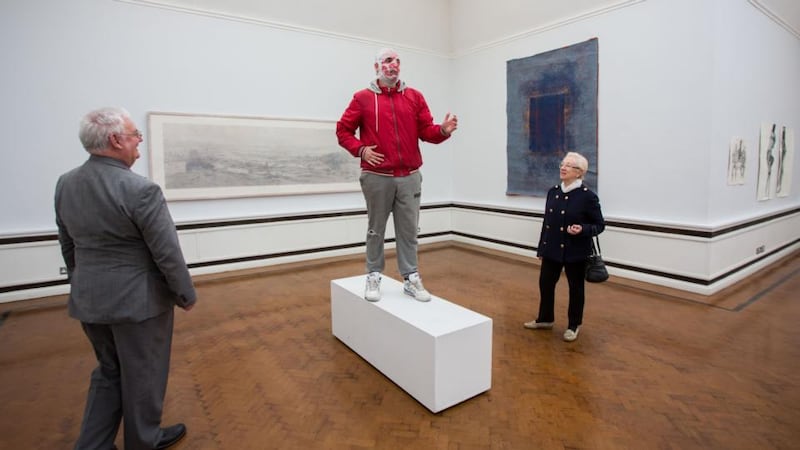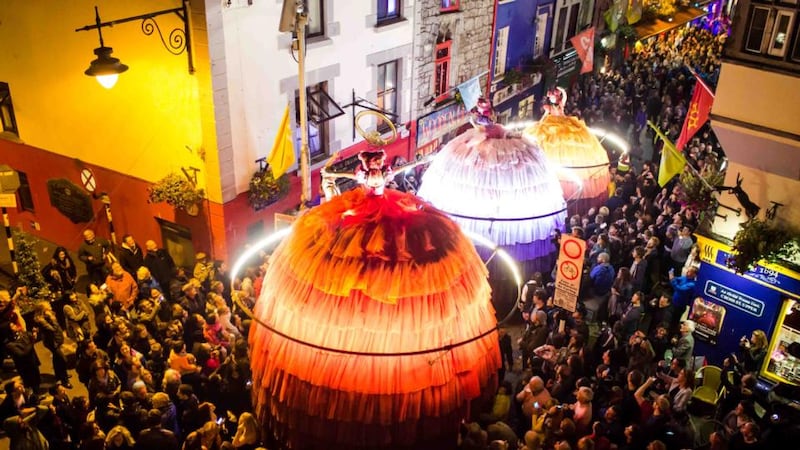What links Athens, Florence, Paris and Cork? They have all held the title European Capital of Culture. The programme began in 1985, after Melina Mercouri, then the Greek minister of culture, noted that culture wasn't given the same attention as politics and economics.
Initially celebrating the wealth of European heritage, the title, with its attendant year-long cultural extravaganza in the host city, went to the obvious candidates, including Berlin, Amsterdam and Dublin, which in 1991 became the seventh city to be so distinguished. But, hand on heart, who can say that in the intervening years they have beaten a path to Maribor in Slovenia, Mons in Belgium or Essen in Germany? Who can name five cultural highlights in Guimarães in Portugal, Stavanger in Norway or Umeå in Sweden?
As Galway, Limerick and the trio of Wexford, Waterford and Kilkenny (under the banner of the Three Sisters) vie for the accolade in 2020, what's involved, what is at stake, and why would they want it?


Rotation of countries
Things have changed since the early years. Nowadays the designation is given to two cities a year, with a rotation of countries to ensure fairness. We will share 2020 with Croatia, where the city of Rijeka has already been chosen.
Another thing that has changed is that, since 2004, the selection of each European Capital of Culture is based less on existing cultural infrastructure and heritage worth celebrating than on the potential for socio-economic development and cultural transformation. Thus the small southern Italian city of Matera, home to the extraordinary ancient Sassi cave dwellings, beat the almighty Venice to the 2019 designation. What the cities get out of it is a small amount of EU money, finance from their own governments and the chance to leverage sponsorships and partnerships in the name of culture and regeneration.
But wait, wasn't Limerick already City of Culture? Well, yes and no. Individual European countries, including the UK and Italy, have begun to nominate their own cities for national city of culture. In the UK, a city is chosen every four years; Derry was the first in 2013. Hull is up next in 2017.
Limerick was Ireland's first national City of Culture, having been selected without open competition to hold the title in 2014. There were the inevitable headlines and stories about last-minute funding decisions and infighting, particularly when three of the senior organisers, including artistic director Karl Wallace, stepped down at the beginning of the year, to be replaced by Mike Fitzpatrick. Nevertheless, an economic impact study by Grant Thornton assessed the benefit to the local economy to be just under €44 million, against an overall programme cost of €12 million, €4.5 million of which came from public money.
Nevertheless, the Department of Arts has decided there will be no Irish City of Culture in 2018, despite the original plan being for a four-year cycle. "Due to the level of exchequer funding which would be required, and so as not to dilute the importance of the European Capital of Culture in 2020, it has been decided to defer the next Irish City of Culture," Minister for Arts Heather Humphreys, wrote in a statement.
Fitzpatrick is now running the Limerick team bidding for the European designation in 2020, although he credits Limerick arts officer Sheila Deegan with initiating the process. At stake is a €1.5 million prize from the EU, with €15 million currently earmarked by the Government for the winning city. It's an arduous process.
Of the remaining bids, Limerick perhaps had a good head-start from its 2014 programme, and in addition to providing operational costs, including offices, Limerick City and County Council agreed to allocate €300,000 to enable the preparation of the second-round bid. The three councils behind the Three Sisters bid have committed €650,000, which is, as bid director Katherine Collins says, "a substantial outlay from an economically deprived region and demonstrates our ambition and commitment to developing a region through culture".
Galway was unable to confirm a total figure for local authority support for its bid, but Galway City Council raised commercial rates by 3 per cent in November 2015, ringfencing the resultant €1 million for projects dedicated to the Galway 2020 bid. And the city and county councils also committed an investment to a team of 18, alongside volunteers, working on creating the bid book and programme.
Galway project manager Patricia Philbin says that "such is the passion and energy generated throughout the city and county that [the bid] has set the platform for communities to already implement ideas for the benefit of their communities", although obviously they need money too.
Tangible benefits
Fitzpatrick says Limerick’s 2014 experience “filled us with confidence. Limerick was quite broken, but this made us say, ‘We can do it.’ ”
That all sounds very nice but, looking at the experiences of Dublin in 1991 and Cork in 2005, what are the real, tangible legacies of all that effort?
Una Carmody, former cultural manager at Temple Bar Properties, and now an independent consultant who is co-cultural programme lead with the Three Sisters bid, cites the development of the Temple Bar Cultural Quarter as a direct legacy of Dublin's designation.
Meanwhile, National Sculpture Factory director Mary McCarthy, who was director of programmes and deputy director for Cork 2005, and who also spent time as an assessor for the European Commission, says Dublin's year also boosted the profile of Imma, which opened in 1991.
Cork, she says, "was the first European European Capital of Culture to lead in a year-long arts and health programme, initiated by Tony Sheehan and Ann O'Connor, which took arts projects into healthcare and care settings city and county-wide. This was groundbreaking and became a model of national policy."
That year also saw the inauguration of the Frank O’Connor Short Story Award, the Ocean to City Festival and the Live at the Marquee concerts, which have all survived.
"One of my personal highlights was having [English art critic, novelist, painter and poet] John Berger over, and seeing Cork for a few days through his bright eyes . . . That's legacy," says McCarthy.
What about the backbiting?
So far, so jolly and positive – but what about the backbiting that tainted Limerick in 2014, as well as Cork, when it was European City of Culture in 2005? Fitzpatrick points to an Atlas report published in 2011, which describes a quiz organised by Bob Scott during a conference held in Brussels to celebrate the 25th anniversary of European Capital of Culture. Question 11 was: How many artistic directors have lost their jobs before the year itself? The options were (a) none, (b), all of them, and (c) a rather large number. And the right answer? C.
"Relatively few European Capital of Culture leaders have come through the entire process unscathed," the report writers noted. "In fact, for the European Capital of Culture between 2008 and 2010 [seven cities], so far only one director, Mary Miller in Stavanger, managed to hang on to her job for the duration of the project."
Time to wish the Irish applicants the best of luck, perhaps?
THE IRISH ENTRIES FOR EUROPEAN CAPITAL OF CULTURE 2020
The three contenders are due to present their second-round “bid books” on June 17th. Jury members, from a panel of 10, will make visits during the week of July 12th, and the winner will be announced on July 15th. The full content of their proposed programmes won’t be made public until June, but here’s a sneak peek from the initial bid books we have:
- Galway: Making Waves: Galway already has its brilliant Galway International Arts Festival each July, a Unesco City of Film designation, and is home of the renowned Druid Theatre Company. Its proposed theme focuses on landscape, language and migration, and includes The Galway 2020 Book of Stories, and Fuinneog / Window on the World, a virtual European City of Culture, with 50 per cent of the projects to happen in rural areas. Proposed operating budget: €45.7 million
- Limerick: Multiplicity: Limerick has the experience of 2014 to build on. It is also home to EVA, the highly regarded international art biennial, as well as the Hunt Museum and a strengthening arts community. The proposal focuses on integration, innovation and imagination, and includes setting up residencies across different sectors, and working to develop creative industries, together with international partnerships and cultural infrastructural projects. Proposed operating budget: €35 million
- The Three Sisters: Currents of Culture: Each of the three cities involved in this bid has a rich heritage: Kilkenny's Arts Festival is a considerable draw, alongside Wexford Festival Opera and Waterford's Spraoi. Although having three centres might seem like a disadvantage, it speaks the EU language of crossing borders, co-operation and partnership in a way that could be hard to beat. The initial proposal was based on four pillars: festival development and innovation, creative and cultural economy, social contract for wellbeing, and urban and rural regeneration. It plays to the festival strengths of the cities, and also to the design and education sectors. Proposed operating budget: €31 million












